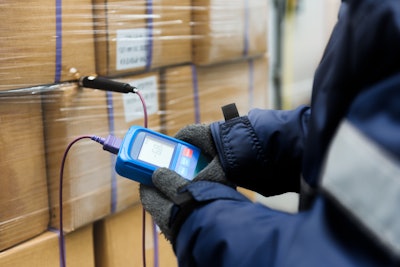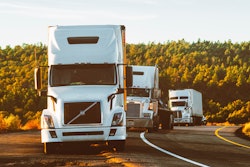
The logistics industry has experienced no shortage of challenges throughout the Coronavirus disease (COVID-19) pandemic -- from navigating the skyrocketing demand for medical supplies, personal protective equipment (PPE), sanitation supplies and household essentials in the early stages to responding to the increase in e-commerce orders we’re still seeing today. The food industry has also faced monumental challenges, largely in maintaining the food supply despite supply chain backups and changing consumer demands (from novelty items to frozen or ready-to-eat products, for example).
Now, with the start of distribution of the COVID-19 vaccine and an ever-increasing interest in fresh and healthy foods, the cold food supply chain in particular is in a difficult position. It must balance previously existing industry-wide concerns and Food Safety Modernization Act (FSMA) regulations with pandemic-imposed changes to processes, driver availability, inspections and sanitation.
Here’s what’s changed and how to make sure products and drivers stay safe in transport.
The growing shortage of drivers
The COVID-19 situation has only exacerbated the driver shortage already in place pre-pandemic. Outside of the pandemic, the driver pool is aging, and few candidates are coming in to replace those leaving the workforce. To compound that shortage, after the virus made its way to the United States, the logistics industry lost thousands of drivers. According the U.S. Bureau of Labor Statistics, 92,000 truck drivers lost their jobs between February and April 2020, and only 42,500 of those jobs have been restored. And, that doesn’t account for absences due to contracting the virus or exposure to it.
As the pandemic continues, the driver shortage will no doubt remain a barrier to moving products across the country and have implications for sanitary transport. For the cold food transport supply chain, this is particularly concerning, as access to fresh and frozen food—and COVID-19 vaccines—depends on the availability of drivers and trucks to get them to and from their destination, all while preserving product integrity.
Ramped up sanitation
The driver shortage, along with the risk of exposure to COVID-19 to shippers, receivers and inspectors alike, has expanded the definition of “sanitary transportation.” Sanitary transportation usually refers to a set of conditions that optimize the protection of a food product during transport -- the packaging, temperature requirements, truck design and steps for preventing cross contamination between raw and ready-to-eat food products, or contamination by non-food products or allergens.
Now, the definition has expanded from measures taken to preserve the integrity of the food, inhibit spoilage and growth of pathogenic organisms and meet FSMA regulations. “Sanitary transport” in the era of COVID-19 includes these measures along with steps for reducing the risk of COVID-19 spread, including sanitizing the cab of the truck between drivers, remaining in the cab while picking up loads, wearing masks when interacting with others and more. In other words, drivers (and shippers and receivers) are now tasked with protecting both their health and the products they’re moving.
Changes in pickup, drop-off and inspections
Beyond sanitation of the cab and truck, two of the biggest changes in sanitary transport of cold food items are in loading/unloading and inspections. In the past, drivers have been able to observe the loading and unloading of a product to ensure the right conditions for sanitary transport. Now, there has to be a greater level of trust that those conditions are being met as drivers are frequently required to remain in their cabs during loading and unloading.
The U.S. Food and Drug Administration (FDA), for example, has had to maintain a greater level of trust during the pandemic. Rather than conducting spontaneous inspections, the FDA has implemented more pre-planned inspections to ensure the protection of its employees and coordinate with shippers and receivers to reduce risk of exposure to the virus. It has also conducted virtual inspections and focused more on auditing records and documentation than on-site inspections to reduce in-person interactions.
The Sanitary Transport Rule and why it matters even more now
As vaccinations are more widely distributed and the pandemic eases, we can however expect the FDA to resume normal inspections, and there will be increased enforcement of FSMA regulations.
As implemented, FSMA’s Sanitary Transport Rule places the primary responsibility for sanitary transport on the shoulders of the shipper. Shippers are responsible for making sure the food product is packaged appropriately, ensuring the truck is in sanitary condition prior to loading, that the temperature of the load is correct and set to be maintained at the specified temperature. Carriers are responsible for maintaining that temperature (and often, cleaning the truck), and receivers for ensuring that they have documentation verifying that all appropriate steps were taken.
The Sanitary Transport Rule helps establish a system in which a problem or food safety risk can be caught before it reaches retailers or the consumer. Yet, with the pandemic presenting an astronomical number of challenges and changes to the industry, it’s likely that a number of food processors and shippers are still in the process of learning how to meet the requirements of the Sanitary Transport Rule. As we begin to return to “a New Normal” or adjust to changes in the industry, it’s going to become all the more important to learn the ins and outs of the rule and how to implement it—not just for passing inspections, but also for protecting the food chain.
So, where do we go from here?
While the logistics industry has had to adapt as a result of the COVID-19 pandemic, we now have key insights about where we can improve, and the industry has shown its ability to rise to challenges never anticipated. Moving forward, that ability to adapt and implement new processes is going to be critical in ensuring sanitary transport, protecting the health of drivers and providing Americans with access to the vaccine, which are all intertwined. Having the right systems in place, reviewing procedures, conducting employee trainings and creating efficiencies throughout the shipping and receiving process are starting points. Obviously, addressing the driver shortage will be a priority, but also making sure to plan ahead, have people available who are trained in using the right products and equipment to clean a truck, utilizing visual inspections and temperature-logging devices and ensuring documentation are all actions shippers and receivers can take immediately. We need to continue to make sanitary transport, in all of its definitions, a top priority. Our food chain—and our health—depends on it.



















